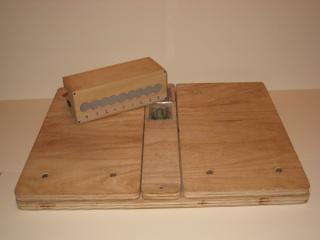Timothy Twillman
Balance Board
A system to aid in diagnosis & treatment of balance and weight-bearing issues.

Classes
Internship in Technology and Social Justice
Internship in Technology and Social Justice
This project consists of two pieces: a platform with embedded sensors and a box giving feedback (via light) as to how a patient's weight is distributed between the left and right feet. It can be used by a therapist to detect weight bearing & balance issues and track progress, by the patient to give feedback and positively reinforce correct weight bearing, or as an aid to exercises that help with weight bearing & balance. It was developed primarily for use by stroke patients.
Background
We started by asking the Occupational Therapy staff at the Metropolitan Hospital what issues they found to be most probematic in treating patients. Several times we heard that determining how patients were distributing their weight while standing was a major problem (and especially when the patients were using the "standbox", a wrap-around table to aid in supporting and protecting patients as they did standing exercises). Tish Campbell and I started by doing research on the Internet. Tish then had patients stand with each foot on a bathroom scale to get an idea of how they were distributing weight. I built a prototype sensor system and we tested it with patients for about a month, and we got feedback from the Metropolitan Hospital staff. Finally we built the current iteration of the Balance Board.
Audience
Occupational Therapy staff, and their patients with balance and weight-bearing issues.
User Scenario
Use is simple; the balance board and the associated light box are simply turned on, then a patient is asked to stand on the board (with some kind of standing stabilization apparatus if needed). The light box displays a visual representation of how far the patient's weight is from center, with marked positions as follows:
0 indicates a less than or equal to 5% difference between amount of weight on each foot
1 indicates between 5 and 15%
2 indicates between 15 and 30%
3 indicates between 30 and 50%
4 indicates more than 50% difference between weight on each foot.
Implementation
The Balance Board is primarily constructed from oak plywood (because of ease of construction, strength, rigidity and weight). There are four 100-pound Flexiforce (a brand of force sensing resistors) sensors under each pad, which connect to a an Arduino Mini for data processing. Communications are via an XBee transceiver.
The light box is constructed from basswood; it has an Arduino Diecimila and an XBee transceiver. 9 white LED's are used for a visual display.
Conclusion
I learned a lot about force sensors (drift compensation, calibration). I spent a good amount of time on the physical construction and figuring out how to position sensors & hold everything together. I also learned a lot about user testing within constraints -- in a hospital working with patients you have a limited amount of time & not a lot of control over how user testing is going to go.
Background
We started by asking the Occupational Therapy staff at the Metropolitan Hospital what issues they found to be most probematic in treating patients. Several times we heard that determining how patients were distributing their weight while standing was a major problem (and especially when the patients were using the "standbox", a wrap-around table to aid in supporting and protecting patients as they did standing exercises). Tish Campbell and I started by doing research on the Internet. Tish then had patients stand with each foot on a bathroom scale to get an idea of how they were distributing weight. I built a prototype sensor system and we tested it with patients for about a month, and we got feedback from the Metropolitan Hospital staff. Finally we built the current iteration of the Balance Board.
Audience
Occupational Therapy staff, and their patients with balance and weight-bearing issues.
User Scenario
Use is simple; the balance board and the associated light box are simply turned on, then a patient is asked to stand on the board (with some kind of standing stabilization apparatus if needed). The light box displays a visual representation of how far the patient's weight is from center, with marked positions as follows:
0 indicates a less than or equal to 5% difference between amount of weight on each foot
1 indicates between 5 and 15%
2 indicates between 15 and 30%
3 indicates between 30 and 50%
4 indicates more than 50% difference between weight on each foot.
Implementation
The Balance Board is primarily constructed from oak plywood (because of ease of construction, strength, rigidity and weight). There are four 100-pound Flexiforce (a brand of force sensing resistors) sensors under each pad, which connect to a an Arduino Mini for data processing. Communications are via an XBee transceiver.
The light box is constructed from basswood; it has an Arduino Diecimila and an XBee transceiver. 9 white LED's are used for a visual display.
Conclusion
I learned a lot about force sensors (drift compensation, calibration). I spent a good amount of time on the physical construction and figuring out how to position sensors & hold everything together. I also learned a lot about user testing within constraints -- in a hospital working with patients you have a limited amount of time & not a lot of control over how user testing is going to go.
